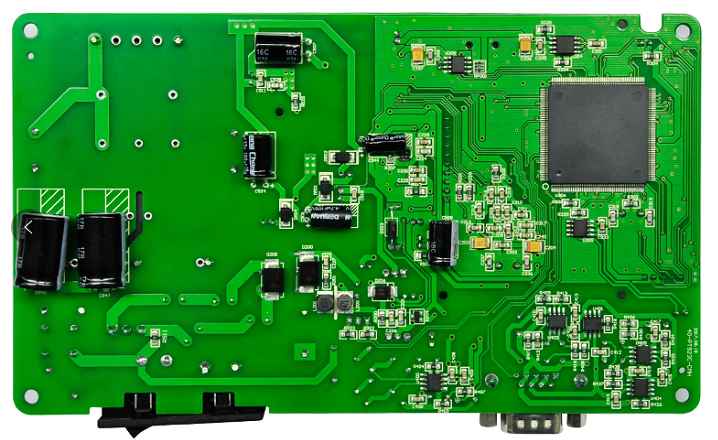About us
FASTPCBA Co.,Ltd
-
 Building 1, Senyang Electronic Technology Park, Guangming High-tech Park, Yutang Street, Guangming District, Shenzhen City.
Building 1, Senyang Electronic Technology Park, Guangming High-tech Park, Yutang Street, Guangming District, Shenzhen City.
-
 F:86-13418481618
F:86-13418481618
-
 [email protected]
[email protected]
 date:2019-04-24 13:57:00
date:2019-04-24 13:57:00
Classification and selection of PCB materials
1, The FR-4 we often choose is not the name of a material.
We often refer to "fr-4" as a code name for a grade of flammable materials. It means a material specification that the resin material must be self-extinguishing after being burned. It is not a material name, but a kind of material grade, so there are many types of FR-4 grade materials used in general circuit boards, but most of them are made of composite material like so-called four-function (Tera-Function) epoxy resin plus filler (Filler).
For example, our company now has FR-4 water green fiberglass board, black fiberglass board, which has high temperature resistance, insulation, flame retardant and other functions. Therefore, when choosing materials, everyone must figure out what characteristics they need to achieve. This makes it easy to purchase the products you need.

Flexible Printed Circuit Board (FPC) is also known as flexible printed circuit board, or soft printed circuit board. A flexible printed circuit board is a product that is designed and fabricated on a flexible substrate by printing circuit.

There are two main types of printed circuit board substrates: organic substrate materials and inorganic substrate materials, and most of them are organic substrate materials. PCB substrates usage are also different for different layers . For example, 3-4 layers use prefabricated composite materials, and double panels mostly use glass-epoxy materials.
2, When choose the board, we need to consider the impact of SMT
In the lead-free electronic assembly process, as the temperature increases, the degree of bending increase when the printed circuit board is heated, so it is required to use a plate having a small degree of curvature in the SMT process, such as a substrate of the FR-4 type. Due to the influence of the expansion and contraction stress on the component after the substrate is heated, the electrode will be peeled off and the reliability will be decreased. Therefore, the material expansion coefficient should be paid attention to when selecting materials, especially when the component is larger than 3.2×1.6 mm. PCBs used in surface mount technology require high thermal conductivity, excellent heat resistance (150 ° C, 60 min) and solderability (260 ° C, 10 s), high copper foil bond strength (above 1.5 × 104 Pa ) and flexure strength (25 ×104Pa), high electrical conductivity and small dielectric constant, good punchability (accuracy ± 0.02mm) and compatibility with cleaning agents. In addition, the appearance is required to be smooth and flat;and warpage, cracks, scratches and rust spots are not allowed.

3, PCB thickness selection
Printed circuit board thicknesses are 0.5mm, 0.7mm, 0.8mm, 1mm, 1.5mm, 1.6mm, (1.8mm), 2.7mm, (3.0mm), 3.2mm, 4.0mm, 6.4mm,the 0.7mm and 1.5mm thick PCB is used for the design of double panel with goldfinger, and the 1.8mm and 3.0mm are non-standard sizes.Printed circuit board size from the production point of view, the smallest single board should not be less than 250 × 200mm, the general ideal size is (250 ~ 350mm) × (200 × 250mm), for PCBs with long sides less than 125mm or wide sides less than 100mm, easy use the jigsaw method. The surface assembly technique specifies that the amount of bending of the substrate having a thickness of 1.6 mm is upper warpage ≤ 0.5 mm and lower warpage ≤ 1.2 mm. Generally, the allowable bending rate is less than 0.065%, which is classified into three types according to metal materials, as shown by a typical PCB. According to the structure, it is divided into three types, and the electronic plug-in is also developed to a high number, miniaturization, SMD, and complexity. The electronic insert is mounted on the board by pins and soldered to the other side. This technique is called THT (Through Hole Technology) plug-in technology. This way, each pin is drilled on the PCB, indicating the typical application of the PCB.
4.Drilling
With the rapid development of SMT mounting technology, conduction is required between the multilayer circuit boards and is ensured by post-drilling electroplating, which requires various drilling equipment. In order to meet the above requirements, PCB numerical control drilling equipment with different performances has been introduced at domestic and abroad. The production process of printed circuit boards is a complicated process. It involves a wide range of processes, mainly in the fields of photochemistry, electrochemistry, and thermochemistry. In the manufacturing process, the number of craft process steps involved is also relatively large. The multi-layer circuit board is taken as an example to illustrate the processing steps. Drilling is an important process in the whole processes. The processing time of the hole is also the longest. The positional accuracy of the hole and the quality of the hole wall directly affect the metallization and mounting of the subsequent hole, and also directly affect the printed circuit board of processing quality and processing cost CNC drilling machine principle, structure and function.The common methods for drilling holes on the circuit board are numerical control mechanical drilling method and laser drilling method. At this stage, mechanical drilling method is mostly used.

 Building 1, Senyang Electronic Technology Park, Guangming High-tech Park, Yutang Street, Guangming District, Shenzhen City.
Building 1, Senyang Electronic Technology Park, Guangming High-tech Park, Yutang Street, Guangming District, Shenzhen City.
 F:86-13418481618
F:86-13418481618
 [email protected]
[email protected]